Introduction
Table of Contents

Looking for the booklet version of this guide to read offline or print ?
0.1 The project
The STEAMER project starts from an important observation based on official research and analysis: STE(A)M education is insufficient for our fast-paced society.
According to the PISA results (Program for International Student Assessment – 2018), 22.2% of 15-years old European are underachieving in math and 20.6% in science demonstrating a critical need for improvement.
In addition to being the basis of many strategic professions for our society, we must remember that STEAM is not only an important current cultural aspect but has also been a key factor in the creation of Europe as a culture over the centuries: from the ancient Greek to the Enlightenment, to the modern scientific programs.
The main objective of the project is thus to boost STEAM education by creating a framework, various tools, and practical examples of Escape Rooms adapted for school education in STEAM, tailored for the teachers and educators of secondary education in order to provide a new range of possibilities to teach STEAM and potentially other subjects.
The framework will take its roots in Game-Based-Learning which was developed to help students approach school subjects with greater enthusiasm and effectiveness.
Thus, starting from the premises of the Escape Room and its entanglements with logical applications, this project also aims at raising learners’ awareness of the European cultural aspects of STEAM and positive scientific role models.
The framework will integrate inclusive elements for disadvantaged learners, specifically the ones with Specific Learning Disorders. The grades of these learners tend to be lower than average in STEAM, not because of a lack of capability but because of their difficulties with some aspects of the formal approach to education (especially in mathematics). The project will also support teachers in developing innovative teaching methods to engage students in the subjects of STEAM through practical experience which would, in result, engage learners with Special Learning Disorders (SLDs) further.
This pedagogical guide is the first output of the project and aims at helping teachers in the process of using pedagogical Escape Rooms as a gamified gateway to STEAM skills.
After an introduction to the nature of the escape room game and its origin (Part 0: Introduction), the guide introduces the following aspects:
- Part 1: Why Escape Rooms are useful for STEAM education
- Part 2: How to integrate ER in the school curricula
- Part 3: How to capitalize on previous knowledge of the students and how to valorize the skills and knowledge developed during the Escape Room
- Part 4: How to animate an Escape Room
- Part 5: How to integrate different profiles of students
Each chapter is designed to answer step-by-step basic questions that the teacher may ask themself during the process of implementing pedagogical escape rooms. These chapters will be followed by a conclusion. Now, let us move on to defining the concept of Escape Room.
0.2 What is an Escape Room?
“You may find yourself inside the Tomb of Pharaoh Tutankhamun, having only one hour to find the key that opens his legendary treasure. Or you may get trapped like Alice in Wonderland, having only 60 minutes to find out the exit and return to the real world. Or you may be kidnapped by a tribe of indigenous people in the middle of the jungle, and you need to escape before it is too late! After making sure it is not a dream, there is only one explanation: you’re in an escape room and you’re about to experience a unique and immersive experience, as if you were in a movie!”
This seems nice and exiting, but what exactly does it entail?
Scott Nicholson – Professor of Game Design and Development at Wilfrid Laurier University in Brantford, Ontario – describes an escape room as “a live-action group game, in which participants physically interpret the characters with their own actions.” The goal of the players is to search for clues and solve puzzles, within one or more rooms, to achieve a specific goal or, more generally, to get out of the room. Moreover, there is the time factor that must considered, making the game even more compelling and challenging. Each escape room is characterized by a given narrative context that defines a setting and involves players within a story, where they assume a role and a mission (which can be linked to the search for the exit door of the room, a certain precious object, the solution of a problem, etc.).
The setting can take players back in time, to a fictional place, into the home of some mysterious character; it can evoke a fairy tale or even get inspiration from a movie. In any case, it is a place from which, for a specific reason, it is necessary to escape from before the end of the countdown. However, the exit door is not so easy to find!
But let us take a step back: how did we come to the conception of this fantastic immersive gaming experience? Although we may consider that escape rooms were created recently, the concept has a thousand-years history, and finds its roots and inspiration in literature, board games, and more recently, role-playing games, television, and even video games.
0.3 The origins of the escape room
The experience of the escape room is based on the model of the maze: the players are imprisoned in a place and they must find a way out of it. We could identify the oldest example of escape room-like experience in the legendary minotaur maze: Theseus is trapped in the maze of Minos to free persecuted prisoners from the monstrous Minotaur and must use all his wits to find the exit!
On the other hand, the concept of treasure hunts, inspired by pirate adventures, is also a forerunner of this experience.
In more recent times, we find the concept of escape room in several television programs whose format revolved around an area containing puzzles, riddles and tests of different kinds to overcome. Examples include “Now Get Out of That” (UK -1981), “The Adventure Game” (UK – 1980), “The Crystal Maze” (UK – 1990) or “Fort Boyard” (France- 1990).
Role-playing games, primarily Dungeons & Dragons (1974), where the task of the participants is to collaborate to overcome the traps, monsters, and above all riddles, also inspired Escape Rooms. The goal is the same for the players: grab a treasure or save a princess! What sets the game apart is the concept that the only way to win is by teaming up!
In the 1990s, solving puzzles and passing logic tests also appeared for the first time in game books (such as “Lone Wolf”), textual adventures (“Colossal Cave Adventure”), and graphic adventures (“Maniac Mansion”).
With the spread of the internet in the early 2000s, digital Escape Rooms appeared. They copied the model of ‘real’ Escape rooms: the player is locked in a room and must get out using the objects and the information that is placed in it.
The evolution of escape room from the virtual world to the real one cannot be attributed to a sole person. Some identify the Japanese as alleged fathers, in particular, SCRAP Enterprises Inc. publishing house. The founder and manga designer Takao Kato, in 2007, built for the first time a Live Escape Room with the goal to immerse participants in the game. The player physically plays in a themed room and solves mysteries to escape within the allotted time. Since then, escape rooms have spread, first in the rest of Asia, and then in Europe and America. In China, the “Beijing Takagism” club was founded in 2012.
Budapest, Hungary, was the first European city where live escape games were made. In 2011, the company Parapark was created. Its founder, Attila Gyurkovics, opened a Live Escape Game without knowing that they were already well developed in Asia. The idea came when developing new proposals for Team Building activities.
In 2012, the first franchise opened in Hungary: “Hint Hunt”, the same year the company SCRAP was moved to the United States under the name “Real Escape Game”. Hint Hunt quickly exported the concept to the UK, and then to France in 2013. That year also saw the arrival of Escape Games in Canada.
An increasing number of escape rooms have been launched and opened to the public, to the point of witnessing a worldwide spread of the phenomenon: the website “Escape RoomDirectory2” counted escape rooms in 97 countries in 2018, for a total of more than 10,000 active escape rooms according to “The Economist” – Business travel Gulliver – Jan 11th, 2019.
0.4 How does an Escape Room work?
0.4.1 For whom, by whom?
A recent survey by Prof. Nicholson (2016) reports that escape room players are extremely heterogeneous, both by age (both adults and minors participate) and by gender. It is precisely the fact that we play as a team that makes the experience deeply appreciated by groups of friends, but this format is now also increasingly used for business experiences and educational purposes.
While escape rooms are most often owned by commercial structures and franchises, there is an increasing amount of independent companies, often run by younger people, who are using their creativity and imagination to offer original and out-of-the-box experiences.
Access is always on reservation and the average price per player ranges from 15 to 30 euros.
0.4.2 How does it work?
In the most popular escape room model, a professional takes on the role of the facilitator: before entering, he instructs the team, typically at least two and up to eight people, about the plot and rules of the game. After locking the smartphones in a safe, as no help must come from the outside except from the facilitator himself, the door closes behind the facilitator, and the players are locked inside the room.
There is an item that is almost always present: a monitor or other mechanism to show players the time available, which usually ranges from 40 to 60 minutes, and to allow the facilitator to transmit useful messages and some help if need be.
The team then begins the search for locks, puzzles, and other clues, such as keys that open drawers containing additional clues or instructions for example, which can allow them to advance until they reach the goal. The team wins if they finish the game and resolve the puzzle within the allotted time.
0.4.3 What is the secret behind the success of Escape Rooms?
According to Matt DuPlessie, president of 5Wits6, a company that offers 18 rooms in 6 different U.S. cities, the three main elements that make the escape room experience attractive to a growing number of users are:
- feeling part of a show
- the possibility of feeling heroic
- the opportunity to face a challenging test
According to DuPlessie, it is precisely the combination of these three elements that allows players to feel immersed in an adventure and therefore to live through the escape room a memorable and exciting experience.
We add as a fourth element of strong involvement and success, the opportunity to work as a team and be a part of it, with a mission that can only be accomplished with the collaboration of everyone.
An interview with managers of Escape Rooms in Italy was conducted to know what are the recurrent concepts that they wish to convey to anyone who decides to live this adventure:
- This is not a game of strength but of logic.
- The route is pre-established and designed so that each clue always leads to the next one.
- Collaboration is the best ally to success.
- The key to the success of an escape room consists is mainly related to three elements:
- the reception: it is essential that the players feel involved even before entering the room and in this, the reception staff plays a decisive role.
- the setting: attention to detail and the study of context will make immersion in the adventure more direct and immediate.
- Plot or story: it is critical that the mission is clear, coherent and motivates the team to put it all together!
0.5 What are the elements that characterize an Escape Room?
Let us go into details now: what are the key elements of an Escape Room?
0.5.1 The story or context
The main element to consider is the setting. Recreated within the room through an appropriate layout, furniture, and objects, the setting can be of a different nature, precisely because there are no limits to the imagination. For example, it may be:
- a contemporary and realistic context, such as a hotel room, a plane, the studio of a photographer,
- a fairytale, fantasy, horror, or mystery context, such as the world of “Alice in Wonderland” or the “Doctor Black’s House”, or like in the “Cluedo” game,
- a context inspired by famous or legendary films and/or literary characters, such as Dracula’s home in Transylvania, the Indiana Jones studio or the world of Jumanji,
- a historical context, such as ancient Egypt, a medieval house, an old-World War II aircraft, etc.
Since in an escape room everything becomes possible, it is up to the skill and imagination of those who design them to surprise players with a fascinating story and with unexpected special effects that make the context as believable as possible, while being unpredictable at the same time.
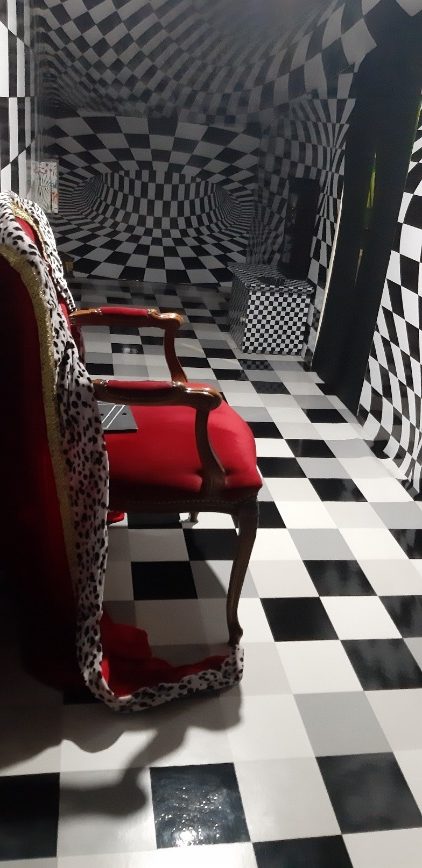
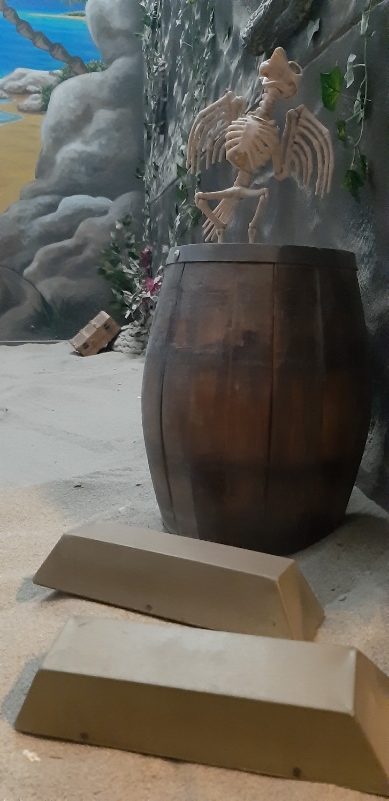


Rooms from Escape Room – Terni (IT)
0.5.2 The atmosphere
The lighting and sound aspect also play a key role: it is obvious that those who designed the experience thought to set it by day or night, to convey an atmosphere of mystery or magic, so lights and music are crucial to recreate the right ambiance.
The ambiance and context can change as time goes by (for example, as time flows you could move from day to night) or with the transition from one room to another (for example, starting the experience in a room then “to take a leap in time and be in the same room as it was 500 years before, just by unlocking a door!”).
The game environment and everything that it contains (furniture, objects, decorative solutions) are what makes the immersion of the player possible. By “immersion” we mean here the experience of being psychologically transported to a simulated, realistic, or fantastical place (Murray, 1997).
0.5.3 The Clues, Codes and Locks
In addition to everything that is purely scenic, the room will then have to be filled with functional objects to the game path: following a logical line, there will be a string of connected clues that aim to bring the players to their goal (for example, the key that opens the last door, a cure, the treasure scope, etc.)
Clues are often conveyed through messages or objects but are not directly recognizable and identifiable, as they are protected by puzzles, padlocks, logic games, codes, etc.
- objects to open (secret doors, drawers, chests, locks, padlocks)
- items to open things with (keys, codes, tools)
- objects that convey games of skill and logic (in some cases the solution of which cannot be obtained independently but requires the intervention of one or more teammates)
- distractors, false clues, disturbing elements
Naturally, everything has to be as consistent as possible with the setting and the story that drives the adventure.
Challenges and puzzles are varied and consist of mathematical calculations, manipulation of objects, encrypted messages, etc. For this reason, teamwork is valuable, as it allows you to combine different skills and abilities..
- keyed
- numerical combination
- alphabetical combination
- alphanumeric combination
Each code/key corresponds to an enigma.
0.5.4 The actors
In some types of rooms, you can also find actors who convey one or more puzzles. This of course makes the experience even more compelling. The actor or actors represent a character from the story and embody an element of strong interactivity.
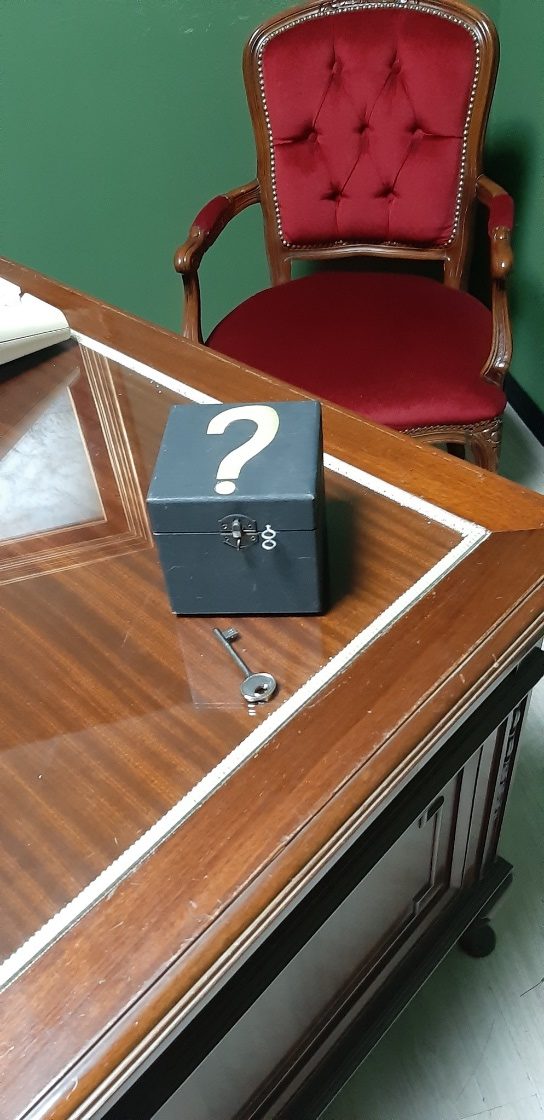
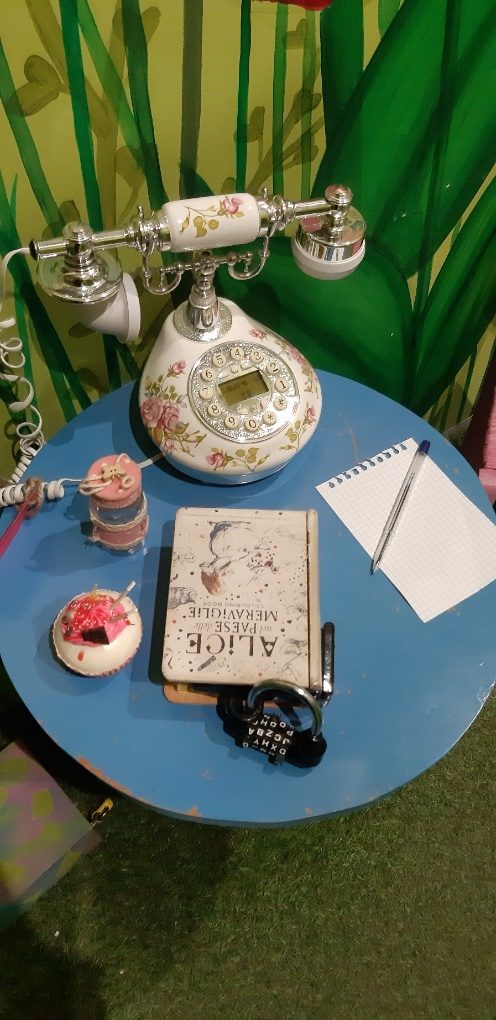
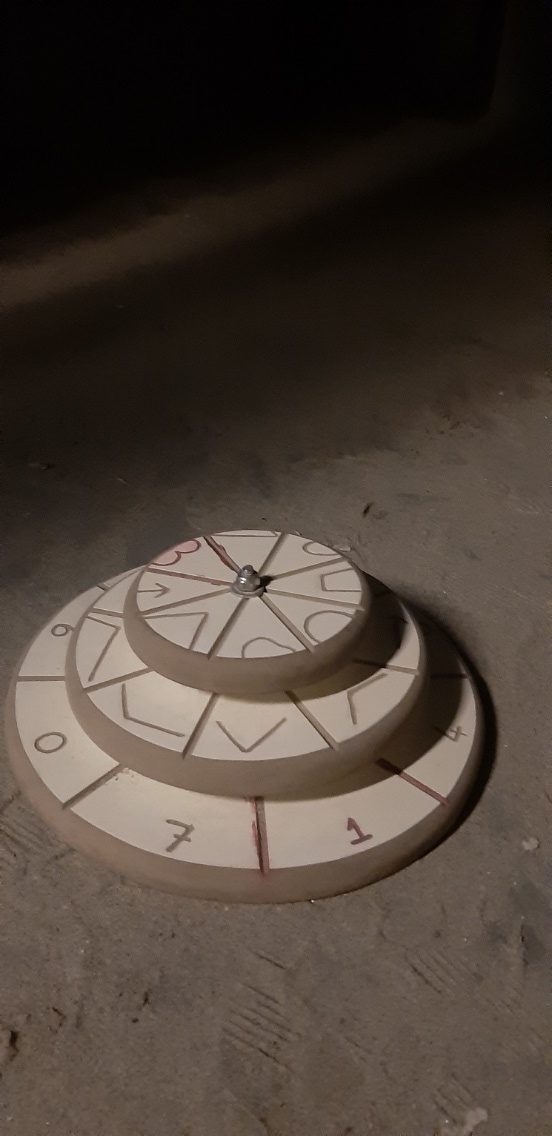
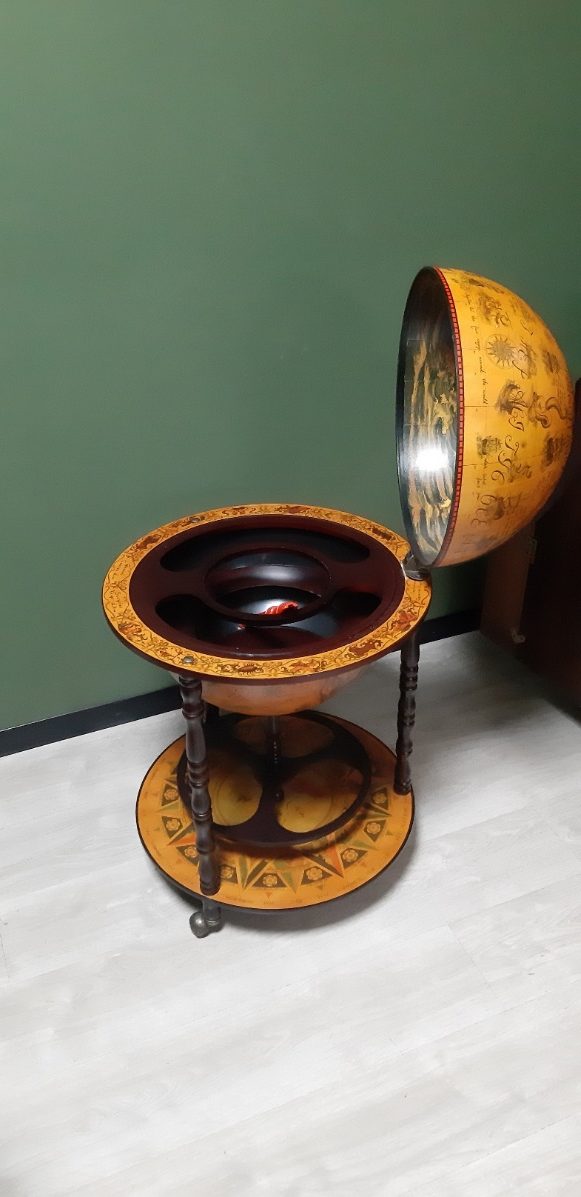

Enigmas, objects and actor from Escape Room Terni (IT)
The escape room model has numerous variations that have different characteristics, although all revolve around the concept of solving puzzles to succeed, whereas it is individually or in teams. In addition to the classic ‘leaving the room’ set-up, we can find other formats such as the following:
0.6.1 Escape Box
These are real board games, which can be purchased and used any time. The playing board and various items in the box create a path to unlock the mystery. Here, the time factor is almost always present in the form of a timer. More or less modern, it displays the countdown and adds a time pressure that creates an atmosphere of urgency. Engagement in the story can be achieved by introducing the context, either orally, or by reading the introduction provided in writing, or even in digital or audio-recorded form. Sometimes the role of the facilitator is replaced by a decoder that tells the story, illustrates the mission, and can provide useful suggestions. Again, it is often a team game: whether you win or lose, it is as a team, every player has to do their part. Teamwork is therefore essential to solving the puzzles on time.
0.6.2 Escape Book
Escape books are a series of puzzles, and logic games that act as the protagonists of an adventure that test the ingenuity and perseverance of the reader, built with a completely original narrative formula. Instead of reading a polar/thriller or an adventure as a mere spectator, the reader becomes the protagonist and must solve puzzles, brainteasers, optical illusions, and anagrams to resolve the mystery.
The resolution of each puzzle allows you to continue reading the book, not from the next page as in the traditional books, but from the one whose number coincides with the code found solving the previous puzzle. There is also the possibility of receiving help at any time the final pages of the book, which usually contains a section where you can find clues that help you solve the riddles you came across.
0.6.3 Cards
Similar to escape boxes, they simulate the experience of a real escape room to bring it to the table using a single deck of about a hundred cards. Players (usually 1 to 6) are faced with a plot and a common goal to achieve in a given amount of time, a series of puzzles to be solved, locks to open, and codes to decrypt to complete the mission. Again, these are almost always collaborative games, where the group’s ability to solve conundrums determines the team’s final score. Turning one card at a time, the group discovers the enigmas and cooperates to find the solution. Once the solution is found, the players accumulate points or penalties if there is a wrong answer. They are characterized by being ‘one-shot’: the adventure can only be solved once. To redo it would be a duplication of the game as the conundrums’ sequence stays the same.
0.6.4 Virtual Escape Room
A lot of websites offer a virtual escape room format where the person explores different rooms in the form of screens. The experience is a little limited immersion-wise but is interesting because these types of escape rooms may be available anytime, anywhere, if you have a computer and an internet connection. They can be solved both in groups and alone. The idea here is to solve a mystery by resolving enigmas and exploring the decor of the different screens to find clues within an allotted time.
Some teachers use a combination of virtual escape rooms and physical clues by hiding clues in the slides of their lessons and the pupils having to find them and resolve the mystery. They can also enter the solutions into a Google form that is password-coded to get to the next riddle. Platforms such as Genially offer relevant support to create these kinds of virtual Escape Rooms.
0.6.5 Virtual Reality Escape Room
A VR escape room consists of a three-dimensional gaming environment that allows you to immerse yourself and perceive things in that environment. The experience is made possible due to HMD (Head Mounted Display) devices, which can be of various types (helmet, glasses, etc).
Once worn, they allow you to immerse yourself completely (visually and acoustically) in a virtual sensory experience. The vision through an HMD is stereoscopic, which means that it provides a different image for each eye, and, through motion sensors, it is possible to change the view through simple head movements, just like in physical reality. The ability to equip players with controllers similar to a joystick to use their hands and manipulate objects inside the virtual environment makes the experience even more interactive. Unlike the traditional escape room, in this case, the content and the setting are located in the virtual environment. In the case of multiple people participating, it is possible to see the avatar of other players, communicate and interact with them (for example, exchanging virtual objects), and maintain all the dynamics of physical escape room cooperation.
The most obvious advantage of a VR escape room is that the same physical environment can be used for endless game scenarios since the content is digital and can be uploaded and saved as in any video game. It also becomes possible to play with people who are physically in different locations.
0.6.6 Breakout box
A breakout box functions in a similar way to an escape room, the only difference being that the group needs to break into a box instead of trying to get out of the room. The scenario could be for example, people needing to break into a safe to find a cure to a fatal disease for humankind before the disease spreads too wide. They usually come in the form of a box that is locked with multiple locks and multiple layers of security. Some breakout boxes come in the form of a locked box inside another locked box, etc. The main advantage of a breakout box is its versatility and easy use. They may be brought anywhere easily and do not take a lot of space or a lot of time to install..
As we see, there are many different sorts of Escape Rooms and endless possibilities of uses, themes, and configurations. In this manual, we will concentrate on pedagogical Escape Rooms. This type of Escape Rooms is usually usable in a classroom where it is easy to install materials and clues. While they can take any format given the right amount of time, expertise and means, pedagogical ER are usually Escape Boxes or Breakout Boxes which are highly practical. Lastly, virtual ER on computers and EB are also an option. Now that we know what kind of tools and formats are available, let us explore why Escape Rooms are useful for STEAM education specifically.
